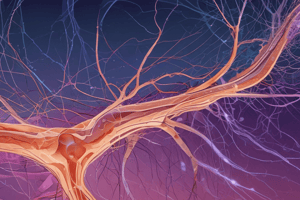Podcast
Questions and Answers
Which of the following veins unites with the external jugular vein in the lower neck area?
Which of the following veins unites with the external jugular vein in the lower neck area?
- Cranial vena cava
- Brachiocephalic vein
- Cephalic vein (correct)
- Subclavian vein
Arteries and nerves typically lie superficial to veins in the body.
Arteries and nerves typically lie superficial to veins in the body.
False (B)
What structure continues as the axillary artery after the subclavian artery?
What structure continues as the axillary artery after the subclavian artery?
brachial artery
The right and left common iliac veins unite to form the _______.
The right and left common iliac veins unite to form the _______.
Match the following vessels with their corresponding locations:
Match the following vessels with their corresponding locations:
Flashcards
Nerves, Vessels and Pathways
Nerves, Vessels and Pathways
Veins, arteries, and nerves often travel along similar pathways in the body.
Location of Larger vessels and Nerves
Location of Larger vessels and Nerves
Larger vessels and nerves are typically located deeper within the body, often protected by muscle layers.
Arterial and Venous Depth
Arterial and Venous Depth
Usually, arteries are found deeper than veins in the body.
Cephalic and External Jugular Veins
Cephalic and External Jugular Veins
Signup and view all the flashcards
Brachiocephalic Veins and Cranial Vena Cava
Brachiocephalic Veins and Cranial Vena Cava
Signup and view all the flashcards
Study Notes
Peripheral Nerves and Vessels Lab
- Veins, arteries, and nerves follow the same pathway through the body
- Larger vessels and nerves are deeper within the body, protected by muscle layers
- Arteries and nerves typically lie deeper than veins
Head and Neck
- Images show the external jugular vein, internal jugular vein, vagosympathetic trunk, and common carotid artery
- Other structures, like the mandibular salivary gland, parotid duct, and mandibular lymph nodes are also identified
Carotid Artery
- The common carotid artery bifurcates into the internal and external carotid arteries
- Images show these structures in various anatomical views
Head and Neck (additional structures)
- Images depict additional structures such as the mandibular salivary gland, parotid duct, and the mandibular lymph node
Head
- Images display the facial vein and facial artery.
- Branches of the facial nerve are also shown.
Branches of Cranial Vena Cava
- Diagram illustrates the right and left external jugular veins, brachial veins, brachiocephalic veins, azygous vein.
- Also, left internal jugular vein, left subclavian vein, left axillary vein, left brachial vein.
- The cranial vena cava is formed by the union of the right and left brachiocephalic veins.
Thoracic Limb Veins
- The cephalic vein connects with the external jugular vein in the lower neck
- The subclavian and external jugular veins combine to form the brachiocephalic vein
- The right and left brachiocephalic veins unite to form the cranial vena cava
The Brachial Vein
- The brachial vein continues as the axillary vein and then as the subclavian vein.
- The name of the vein changes based on the body region it passes through.
Thoracic Forelimb Veins
- Images show views of the cephalic vein, accessory cephalic vein, median vein, and ulnar vein at different anatomical positions (lateral, cranial, medial, caudal).
Branches of Thoracic Aorta
- Diagram shows the right common carotid artery, right axillary artery, right brachial artery, left common carotid artery, left subclavian artery, left axillary artery, left brachial artery, brachiocephalic trunk, and the aorta.
- Also, the pulmonary artery and the diaphragm.
Thoracic Limb Arteries
- The subclavian artery continues as the axillary artery and then the brachial artery.
Arteries of Thoracic Forelimb
- Images showcase views of the median artery and ulnar artery from different anatomical viewpoints (lateral, cranial, medial, caudal).
Thoracic Limb Nerves
- The brachial plexus is a major nerve structure in the area
- Images provide views of the musculocutaneous nerve, radial nerve, axillary nerve, median and ulnar nerves.
Nerves of Thoracic Forelimb
- Images show the median nerve, ulnar nerve, palmar branch of the ulnar nerve from different anatomical positions
Branches of Caudal Vena Cava
- Diagram depicts the caudal vena cava, hepatic vein, ovarian vein, renal vein, testicular vein.
- Also, the common iliac vein, internal iliac vein, external iliac vein, femoral vein, and the medial saphenous vein.
Pelvic Limb Veins
- The saphenous vein continues on as the femoral vein
- The femoral vein joins the external iliac vein.
- The external and internal iliac veins join to form the common iliac.
- The right and left common iliac veins unite to form the caudal vena cava.
Pelvic Limb Veins: Further details
- images show the medial saphenous veins, and their cranial and caudal branches, as well as the lateral saphenous vein and its cranial branch
Popliteal Lymph Node
- The images show locations of the popliteal lymph node.
Branches of Abdominal Aorta
- Diagram illustrates the celiac artery, cranial mesenteric artery, right ovarian artery, caudal mesenteric artery, aorta, left renal artery, left testicular artery, left external iliac artery, left internal iliac artery, left femoral artery, and the caudal artery.
Pelvic Limb Arteries
- Images show the femoral artery, cranial tibial artery, saphenous artery, and dorsal pedal artery in different anatomical views.
Inguinal Lymph Node
- Images display the inguinal lymph node
Pelvic Limb Nerves
- Images show the sciatic nerve, common fibular nerve, tibial nerve, and obturator nerve.
Nerves of Pelvic Limb
- Numerous images show views of the saphenous, sciatic, common fibular, and tibial nerves in varied anatomical views.
Studying That Suits You
Use AI to generate personalized quizzes and flashcards to suit your learning preferences.




